Physical Address
304 North Cardinal St.
Dorchester Center, MA 02124
Osteoarthritis of the hand and thumb is one of the most common symptomatic conditions of the hand, particularly for people over the age of 75 years. Osteoarthritis of the thumb, for example, occurs in one of three females and in one of eight males. Sodha and colleagues have studied the prevalence of thumb carpometacarpal (CMC) arthritis in a consecutive series of patients and found the condition present in 91% of patients over the age of 80 years, with complete joint destruction present three times more often in females. Osteoarthritis affects the small joint of the hand more commonly than any other location in the body and is among the leading conditions requiring hand surgery.
Although the cause of osteoarthritis of the hand still engenders much debate, many suggest mechanical stress is the cause. In a study of over 2500 individuals in China, Hunter and associates found that chopstick use accounted for 19% of thumb arthritis cases in men and 36% in women. Interestingly and perhaps counterintuitively, handedness has not been shown to influence the development of osteoarthritis of the hand.
The indications for surgical reconstruction of the rheumatoid hand have declined over the last 3 decades, but the need for reconstruction of the osteoarthritic hand has remained constant, with thumb CMC joint reconstruction one of the most commonly performed hand surgery procedures. A number of successful procedures have been employed for reconstruction of the arthritic thumb CMC joint. Traditionally, reconstruction for arthritis of the small joints of the hand has primarily involved arthrodesis. In recent decades, joint arthroplasty procedures have been used with increasing frequency and success. Recently, Harris et al. have shown that patients prefer attributes of proximal interphalangeal (PIP) joint arthroplasty, such as motion preservation, compared with the attributes of PIP joint arthrodesis, such as less likely need for repeat surgery.
Physical examination of the hand begins with a careful inspection of the dorsal and palmar surfaces. Several distinguishing characteristics may be obvious in the osteoarthritic hand. At the metacarpophalangeal (MCP) joints, swelling and volar subluxation may be present, with an associated flexion contracture or extension lag. Likewise, the PIP joints may display flexion contractures; a more common distinguishing characteristic is the Bouchard node. Similarly, inspection of the osteoarthritic distal interphalangeal (DIP) joint is heralded by the presence of Heberden nodes, which signifies swelling and periarticular osteophyte formation. Additionally, mucous cyst formation may occur in relation to an osteoarthritic DIP joint.
Palpation of the acutely inflamed osteoarthritic MCP, PIP, or DIP joint will elicit tenderness as well as a sensation of fullness about the joint with loss of the normal bony contour of the joint. While gently holding the joint between the dominant thumb and index finger, the examiner can carefully apply a small amount of pressure to detect tenderness and synovitis. The range of motion of each joint may be limited due to a superimposed flexion contracture. The digital range of motion is often expressed in terms of total active range of motion, approximately 250 degrees. Individual ranges are also measured with normal motion as follows: MCP joint 0 to 90 degrees, PIP joint 0 to 100 degrees, and DIP joint 0 to 60 degrees.
Tendon integrity may be compromised in the osteoarthritic hand. Pathologic conditions of the flexor tendon uncommonly coexist as chronic tenosynovitis of the flexor tendon sheath and can lead to a zone 2 flexor digitorum superficialis (FDS) or flexor digitorum profundus (FDP) tendon rupture. More commonly, the extensor tendons are involved, with ulnar subluxation of these tendons at the level of the MCP joints secondary to failure of the sagittal bands. The result is ulnar drift and flexion positioning of the digits at the level of the MCP joints. In the acute phase of this condition, extensor tendon subluxation and ulnar drift/MCP flexion may be passively correctable and amenable to individual MCP extension splinting for 3 weeks. In the more chronic situation, the only treatment option is surgical release of the tight sagittal bands, with or without intrinsic releases, and extensor tendon realignment.
Erosive or inflammatory osteoarthritis is an uncommon variant of osteoarthritis first described in 1966 by Peter and coworkers. , Similar to primary osteoarthritis, erosive or inflammatory osteoarthritis is more common in women. Interestingly, the symptoms appear abruptly and involve the joints on the radial aspect of the hand while sparing the joints on the ulnar side ( Fig. 11.1 ). The DIP joint is the most commonly affected joint, but the PIP joint is most commonly the symptomatic joint. In some patients, erosive osteoarthritis will seroconvert to rheumatoid arthritis at a later time.
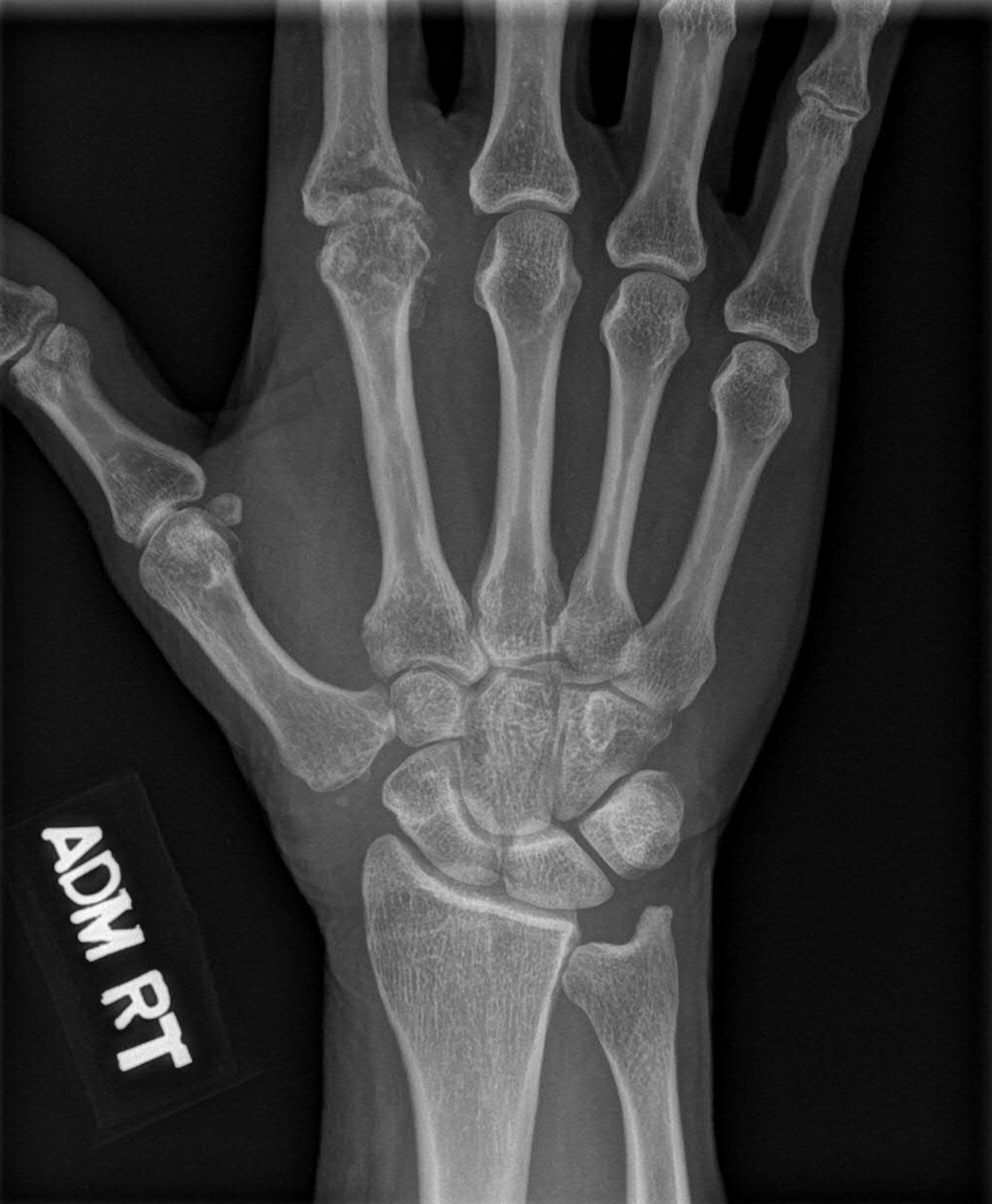
Plain posteroanterior (PA), lateral, and oblique radiographic views can adequately image the osteoarthritic hand. Further detail can be obtained by directly imaging the individual digit, with an attempt made to center the radiograph beam over the joint in question (i.e., the MCP, PIP, or DIP joint). Further definition of the MCP joints can be obtained with a Brewerton view radiograph. Originally described for the rheumatoid hand, this view is obtained by placing the supinated hand on the cassette and flexing the MCP joints 45 to 60 degrees. This view may also be helpful in imaging the hand with osteoarthritis or erosive osteoarthritis. Advanced imaging such as computed tomography (CT) scanning and magnetic resonance imaging (MRI) is seldom necessary for osteoarthritis of the small joints of the hand; however, it may be helpful in the early stages of the condition, showing synovial changes in the joint along with effusion.
The PIP joint is a simple uniaxial hinge joint, stabilized by the extensor mechanism, the collateral and accessory collateral ligaments, the volar plate and articular contact between the bicondylar proximal phalangeal head, and the articular surface of the middle phalanx. The center of rotation of the PIP joint is within the condylar area of the proximal phalanx. Minamikawa and coworkers have shown that in the normal state, the PIP joint may deviate 5 degrees in the radioulnar plane and supinate 9 degrees when subjected to lateral stress. This may increase to 20 degrees of deviation following complete sectioning of the collateral ligaments, with laxity greatly reduced when the PIP joint is in full extension or complete flexion. The primary stabilizers of the PIP joint are the collateral ligaments, and stability of the joint is maintained as long as half of the width of these ligaments remains intact.
There are several unique characteristics of the MCP joints of the hand that can affect their surgical reconstruction and rehabilitation. In the sagittal plane, the metacarpal head has an elliptical shape that influences the arc of motion of the MCP joint such that a cam effect occurs during flexion and extension. The radial and ulnar collateral ligaments of the MCP joint originate along recesses of the metacarpal heads and course obliquely to insert along the base of the proximal phalanx. By virtue of the sagittal elliptical shape of the metacarpal head, the radial and ulnar collateral ligaments of the MCP joints are lax in extension and taut in full flexion. There is a tendency for MCP joint contracture when the joint is immobilized in full extension and must be kept in mind when there is integrity of the MCP collateral ligaments.
Moberg and colleagues and Carroll and Hill reported on some early experiences with interphalangeal (IP) joint arthrodesis, citing a low pseudarthrosis rate. Since these early experiences, many authors have reported successful results using a variety of techniques ( Table 11.1 ).
| Study | Fixation Technique | Time to Union (weeks) | Failure Rate (%) |
|---|---|---|---|
| McGlynn et al. | Cup and cone, Kirschner wire | ∼8 | 0 |
| Lewis et al. | Tension and mortise, Kirschner wire | ∼8 | 2 |
| Khuri | Tension band wire | 7 | 0 |
| Hogh and Jensen | Kirschner wire/cerclage | 8 | 7–16 |
| Granowitz and Vainio | Crossed Kirschner wire | — | 7 |
| Carroll and Hill | Cup and cone, Kirschner wire | 6–8 | 10 (all cases) |
| Lister | Intraosseous wire | 10 | 13 |
| Burton et al. | Kirschner wire | 8 | 0 |
| Buchler and Aikin | Plate | — | 8 |
| Ayres et al. | Herbert screw | — | 2 |
| Moberg and Henrickson | Bone peg | ∼6 | 6 |
| Allende and Engelem | Tension band wire | — | 0 |
| Wright and McMurtry | Plate | — | 0 |
| Potenza | Bone peg and Kirschner wire | 7 | — |
| IJsselstein et al. | Kirschner wire | ≈6 | 8 |
| IJsselstein et al. | Tension band wire | — | 3 |
| Stern and Fulton | Kirschner wire | — | 12 |
| Stern and Fulton | Interosseous wire | — | 12 |
| Stern and Fulton | Herbert screw | — | 11 |
| Katzman et al. | Herbert screw | 8 | 0 |
| Stern et al. | Tension band wire | — | 3 |
| Braun and Rhoades | External fixator | ≈8 | 0 |
| Seitz et al. | External fixator | 6 | 9 |
| Teoh et al. | Compression screw | 8.2 | 4 |
| Watson and Shaffer | Kirschner wire | 6 | 0 |
| Leibovic and Strickland | Kirschner wire | 10 | 21 |
| Leibovic and Strickland | Tension band wire | 11 | 5 |
| Leibovic and Strickland | Herbert screw | 9 | 0 |
| Leibovic and Strickland | Plate | 12 | >50 |
The first reported attempt at prosthetic replacement of the PIP joint was made by Burman using a Vitallium cap for arthroplasty in 1940. In 1959, Brannon and Klein from Lackland Air Force Base, Texas, published the first series of digital total joint replacements. This was a hinged prosthesis initially indicated in PIP joint fractures and fracture-dislocations. Flatt reported on a more rotationally stable device with two intermedullary prongs as opposed to the single-pronged Brannon prosthesis ( Fig. 11.2 ). In 1979, Linscheid and Dobyns developed the surface replacement arthroplasty (SRA) for the PIP joint. The development of these linked and unlinked metal arthroplasty designs was paralleled by the development of the Swanson silastic implant in the 1960s, which has been successful for management of osteoarthritis in both the MCP and PIP joints. Carroll and Taber reported on soft tissue interposition techniques for management of osteoarthritis of the IP joints of the hand.

The main indication for DIP joint arthrodesis is primary osteoarthritis or posttraumatic arthritis. The patient should have intractable chronic DIP joint pain, static deformity, or instability that interferes with activities of everyday living. The symptomatic digit may become less painful as stiffening occurs with time and the deformity less of an impairment as the patient adapts, rendering the need for surgery less imperative. Therefore it is advisable to treat the patient nonoperatively with analgesics, hand therapy modalities, a removable finger-based splint, and a period of prolonged observation prior to proceeding with surgery. DIP joint arthrodesis may be indicated following joint degeneration because of remote septic arthritis.
Contraindications for DIP arthrodesis include active infection of the finger, septic arthritis of the DIP joint, or an open wound in the proximity of the joint. Other potential contraindications include unhealthy atrophic skin over the joint, as may occur following long-term steroid usage. Patients with compromised blood flow or ischemic fingers should not undergo DIP joint arthrodesis.
Critical to the preoperative assessment of the patient and planning for care are dedicated PA and lateral radiographs of the affected finger. It is important to identify the appropriate implant for arthrodesis based on the size of the distal phalanx. It is also important to identify any periarticular degenerative cyst formation or bone loss that may require bone graft.
DIP joint arthrodesis can be performed under regional anesthesia or digital block anesthesia using finger tourniquet control. The technique involves a dorsal exposure of the joint, followed by removal of all remaining articular cartilage. The natural contour of the head of the middle phalanx may be retained if it matches well with the resulting contour of the base of the distal phalanx following removal of articular cartilage. Typically, a reasonable fit is obtainable, but a bone defect causing shortening may be encountered, which may require either allograft or autograft supplementation. Alternatively, the head of the middle phalanx and the base of the distal phalanx may be contoured into a cup and cone match. Full extension to slight flexion is desirable for positioning of the joint, and the position is limited due to fixation considerations. Fixation techniques for DIP joint arthrodesis include percutaneous pin fixation or low-profile, variable-pitch compression screw fixation.
Percutaneous pin fixation configurations include crossed pinning of the arthrodesis site or percutaneous longitudinal pinning with two parallel Kirschner wires. Longitudinal pinning is best done by first advancing two 0.045-inch wires antegrade through the distal phalanx articular surface and exiting the tuft of the distal phalanx. The arthrodesis site is then reduced. The wires are subsequently advanced in a retrograde manner to stabilize the arthrodesis site ( Fig. 11.3 ).
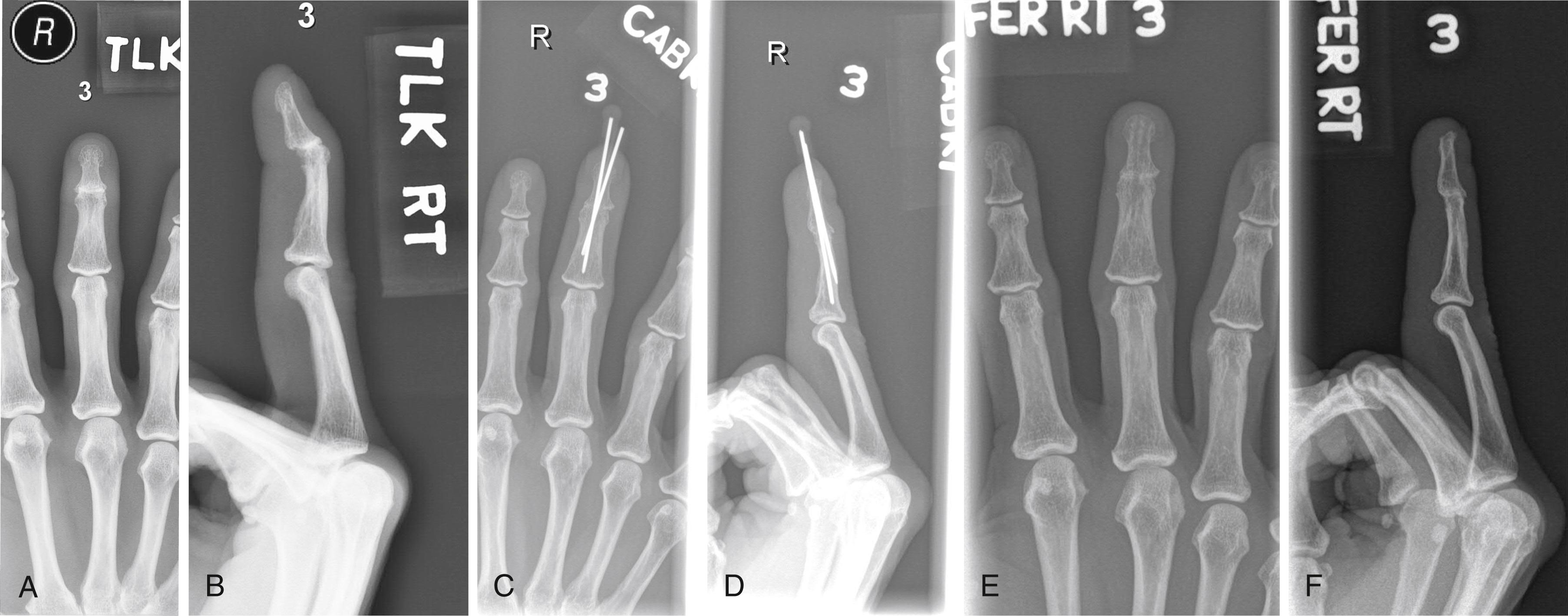
If a headless variable-pitch screw is chosen for fixation, attention must be paid to the dimension of the distal phalanx. In smaller individuals, particularly in the small finger, the diameter of the bone may not accommodate the caliber of the screw. This technique is detailed below.
DIP joint arthrodesis is accomplished through the extensile “H” incision ( Fig. 11.4 ). Full-thickness skin flaps are elevated, and the terminal tendon is exposed. The terminal tendon is incised transversely, exposing the articular surfaces of the joint. Hyperflexion of the joint facilitates exposure of the articular surfaces. I avoid excessive shortening of the finger by using a 2-mm high-speed bur to remove the remaining articular cartilage, microcurettes, or a small rongeur, preferably following the natural contours of the head of the middle phalanx and the articular base of the distal phalanx. Though desirable, a tight, flush contact of surfaces is often not achieved. Hence, the arthrodesis site is supplemented with a small portion of autograft or allograft material of choice. The position of full extension is generally preferred.
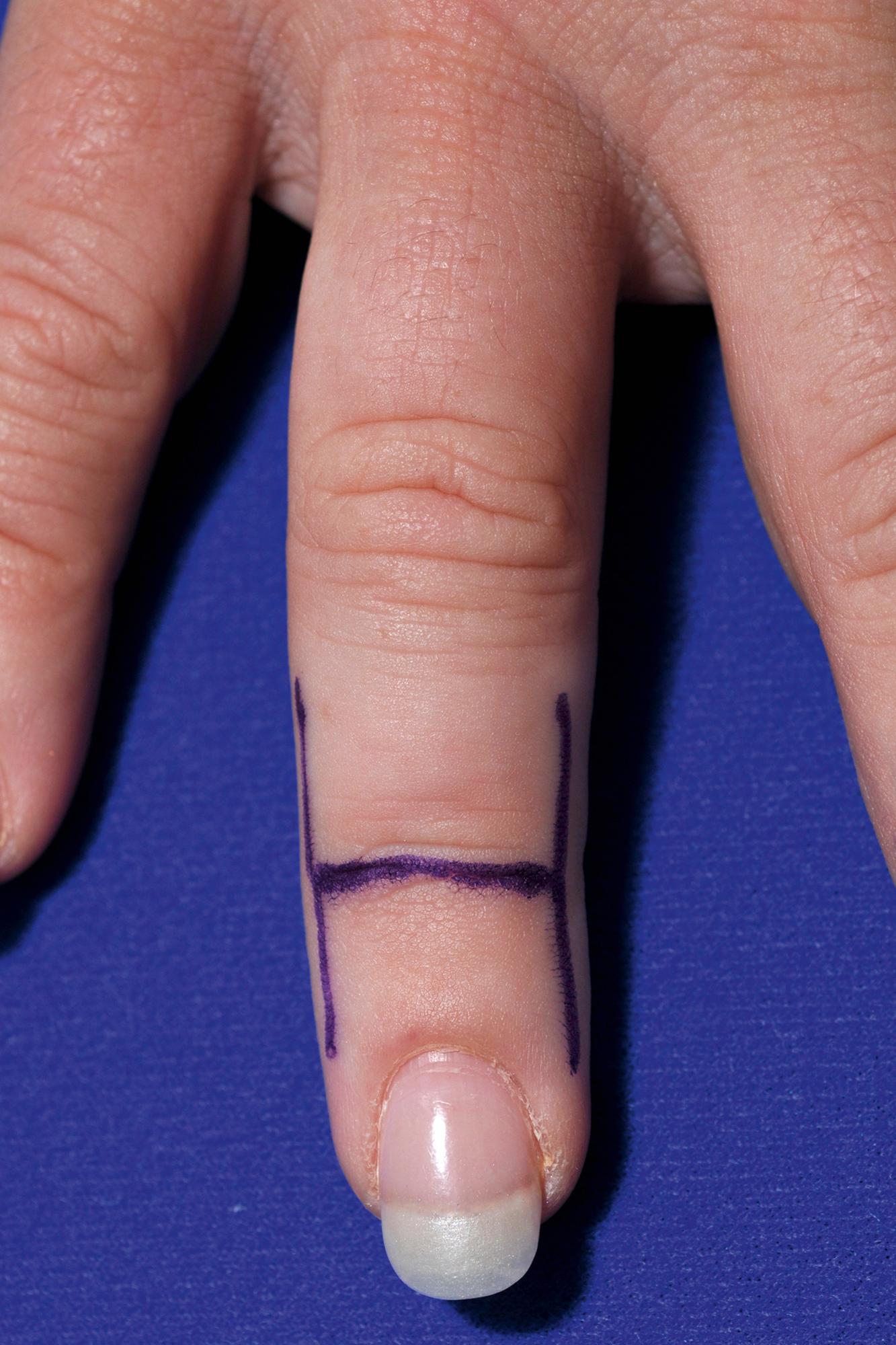
For fixation, I prefer a variable-pitch, headless compression screw no larger than 2.4 mm in diameter using biplanar fluoroscopy. Smaller diameter headless compression screws are now available, measure as small as 2.0 mm, and are ideal for small digits in patients with erosive or inflammatory arthritis. This affords immediate, stable fixation. Initially, a guidewire is driven retrograde across the DIP joint with the joint compressed and reduced in extension. The guidewire is advanced to the level of the subchondral bone of the base of the middle phalanx ( Fig. 11.5 ). A cannulated drill is advanced over the guidewire, and a
Osteoarthritis
Posttraumatic arthritis
Postseptic arthritis
“H” incision
Articular cartilage removed and joint surfaces matched (alternative is cup and cone technique)
Fixation with headless screw or Kirshner wires in extension or slight flexion
Headless screws can cause inside-out contact with the nail bed. In these instances, screw fixation is abandoned and Kirshner wire fixation performed.
Immediate motion of the finger is permitted following headless screw fixation.
High union rates can be anticipated with either head compression screw devices or Kirshner wire fixation.
Preoperative planning is important to avoid nail bed complications and prominent hardware.
screw of appropriate length is advanced across the arthrodesis. Care is taken to avoid inside-out contact with the nail bed. It is also important that the distal aspect of the compression screw is completely buried in the tuft of the distal phalanx to avoid screw prominence (see Fig. 11.3A ).
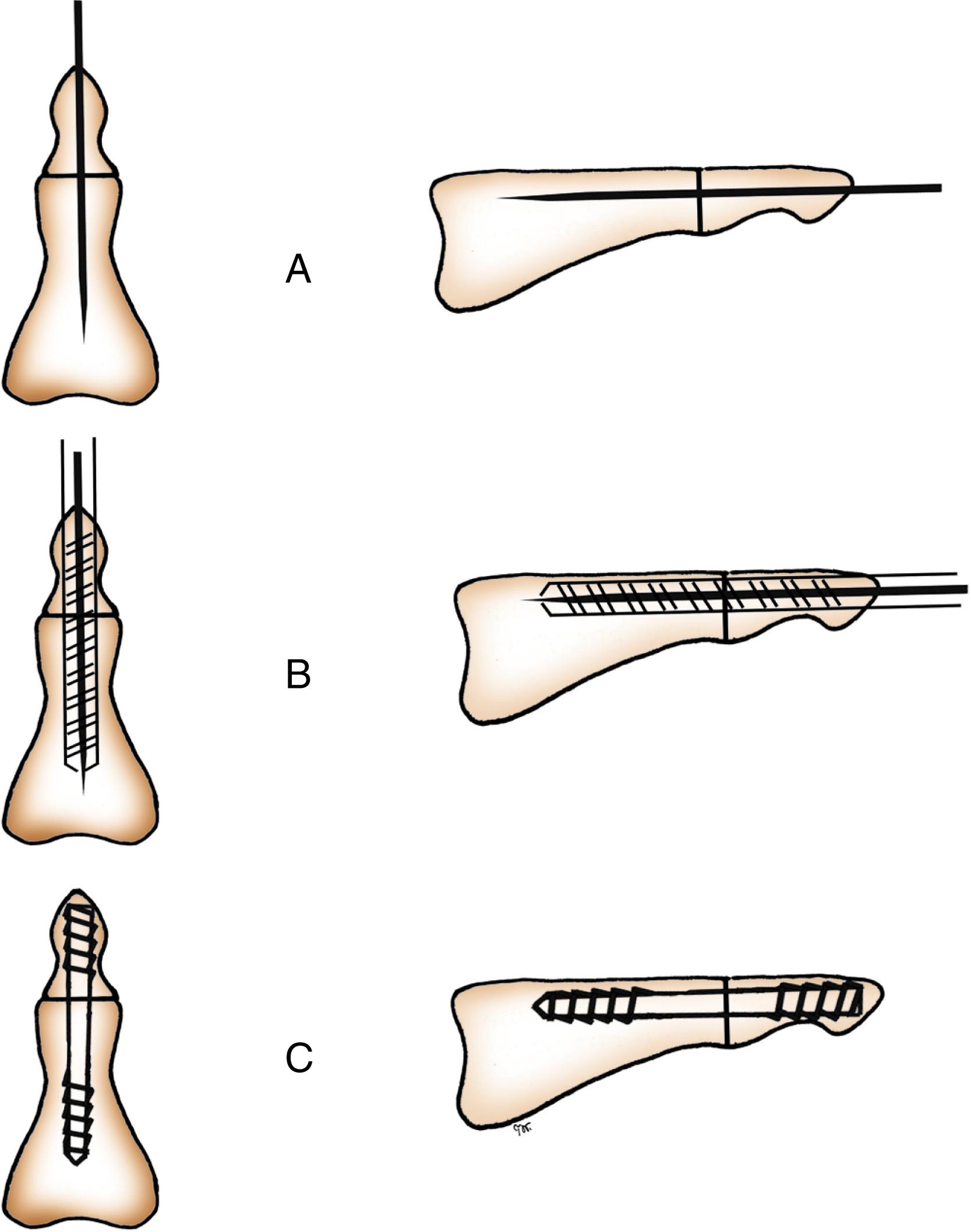
If inside-out contact with the nail bed occurs during placement of the compression screw, screw fixation is abandoned in favor of fixation with a 0.062-inch (1.5 mm) percutaneous Kirshner wire placed longitudinally across the arthrodesis site in a retrograde fashion. If possible, the drill track is packed with autograft or allograft. Placement of percutaneous pins or the cannulated drill bit and variable-pitch screw is done using biplanar fluoroscopy.
At 5 days following operation, the dressings are removed and the wound is inspected. Following DIP arthrodesis with a variable-pitch headless compression screw, a removable finger-based splint is fabricated by a hand therapist. The splint may be removed and immediate motion of the digit initiated. This should include active and passive range-of-motion exercises of the PIP, MCP, and wrist joints. Radiographs are obtained at 6- to 8-week intervals, and the splint is maintained until radiographic healing is evident.
If DIP arthrodesis is performed with percutaneous pin fixation, the wires are cut at the surface of the pulp of the finger and left in place for 8 weeks. The patient is treated with a nonremovable finger-based splint for 4 weeks, allowing active and passive MCP and wrist motion only. This is followed by fabrication of a removable finger-based splint allowing PIP motion at 4 weeks following operation. Radiographs are followed until solid fusion is achieved. The wires are then removed, and unrestricted activity is resumed.
DIP joint arthrodesis is considered a reliable procedure. Accordingly, high rates of union and patient satisfaction can be expected. Burton and coworkers reported a 100% union rate using Kirshner wire fixation, and in 1984 Faithfull and Herbert originally reported on successful union using a headless compression screw. More recently, Cox and colleagues and Matsumoto and associates have reported 94% and 97% union rates, respectively, for different compression screw devices at 12 months and 35 months of follow-up. Alternatively, successful union has been reported using obliquely placed headless compression screws to avoid nail bed complications (96%) as well as using fixation with a small plate placed laterally (100%).
Mismatch between the caliber of the variable-pitch headless compression screw and the diameter of the distal phalanx can result in inside-out damage of the nail bed, particularly in small individuals and particularly involving the small finger. Furthermore, variable rates of nonunion, infection, and hardware prominence at the fingertip have been reported. , Stern and Fulton reported a nonunion rate of 12% and a complication rate of 21%. Less common complications include malunion, cold intolerance, reflex sympathetic dystrophy, paresthesias, PIP joint stiffness, and skin necrosis.
The principal indication for PIP joint arthrodesis is painful primary osteoarthritis or posttraumatic osteoarthritis that is refractory to nonoperative measures. Patients will often complain of diminishing motion of the joint in conjunction with aching pain with use. Other indications are unreconstructible fractures or fracture-dislocations, chronic instability of the joint, or failed PIP joint arthroplasty.
Contraindications for the procedure are recent infection or a poor soft tissue envelope. A relative indication for PIP joint arthrodesis is a history of septic arthritis with residual articular destruction and pain that interferes with function. Bone loss due to trauma or tumor is a relative indication for arthrodesis. In these situations, arthrodesis can be achieved with corticocancellous iliac crest graft and appropriate small plate fixation.
Critical to preoperative assessment and planning are dedicated, high-quality PA and lateral radiographs of the finger centered on the PIP joint. It is important to select the appropriate implant for arthrodesis; surgeon preference is the deciding factor in most circumstances. In cases of trauma where bone loss has occurred, fixation must be planned in order to best accommodate the bone deficiency. It is also important to identify any periarticular degenerative cyst formation, which may necessitate bone graft augmentation and fixation modification.
Arthrodesis of the PIP joint is performed under regional anesthesia and upper arm or forearm tourniquet control. A dorsal longitudinal incision can be used in most patients. In patients with atrophic or compromised skin, a longitudinal incision can create insufficient skin margins for closure. A carefully designed serpentine incision over the dorsal aspect of the affected digit creates a flap well positioned to cover the hardware and arthrodesis site and may be preferred. The articular surfaces are exposed, and an osteotomy of the head of the proximal phalanx and the base of the middle phalanx is performed so that two flush bony surfaces are achieved. This requires the removal of the entire articular surface of the head of the proximal phalanx and the entire articular base of the middle phalanx. Positioning of the PIP joint arthrodesis is critical. The index finger PIP arthrodesis is positioned in 30 degrees of flexion, and the arthrodesis position of each successive finger should be in approximately 10 degrees more of flexion ( Fig. 11.6 ). Realistically, accuracy to the 10-degree level cannot be assessed. In general, an arthrodesis position of 30 to 40 degrees is preferred for the index and long fingers and 50 to 60 degrees for the ring and small fingers in most cases.
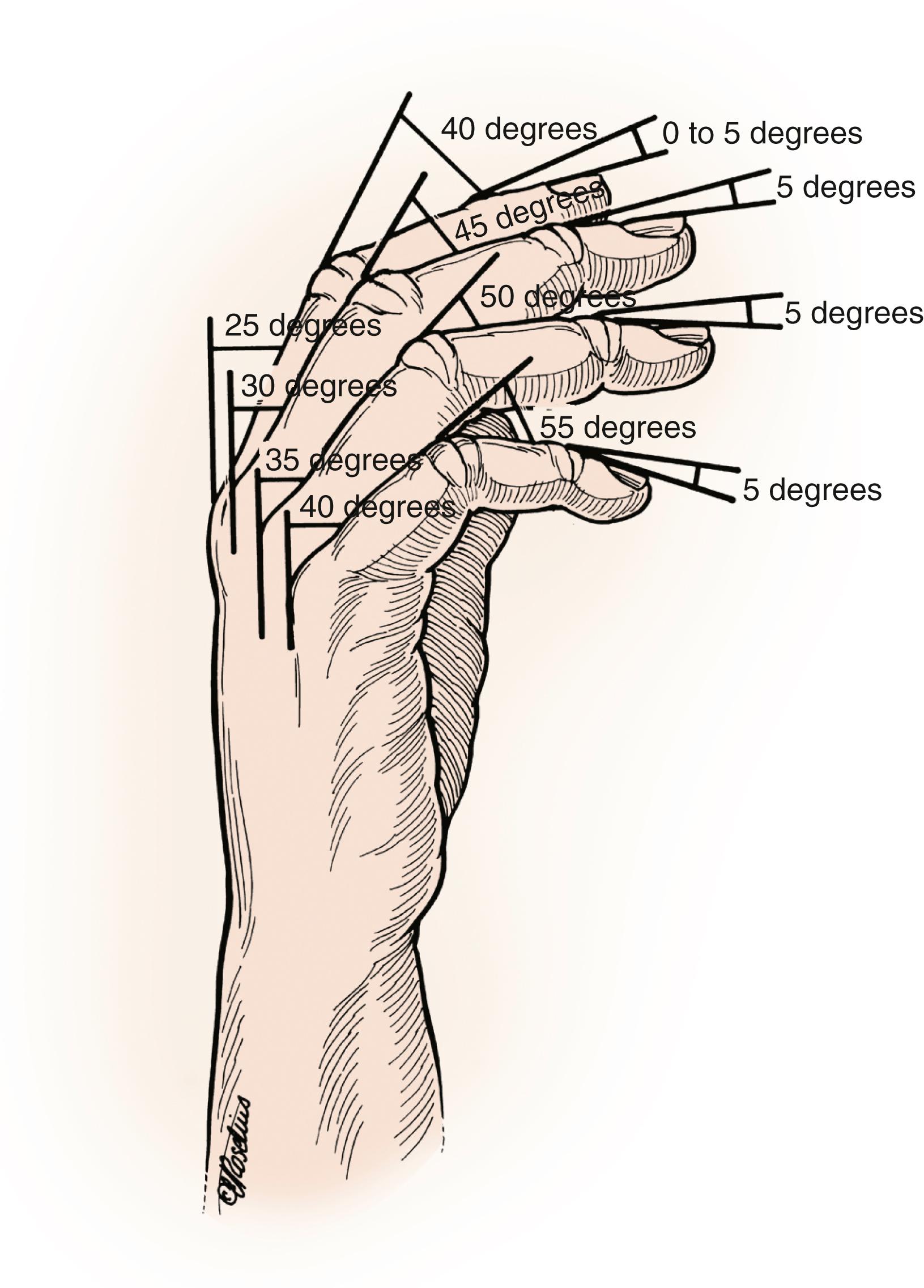
Several fixation techniques are available for stabilization of the arthrodesis. Options include Kirshner wire fixation with or without tension band wiring, variable-pitch headless compression screw fixation, or small joint plate fixation. Tension band wire fixation will be detailed in the following section. Variable-pitch headless compression screw fixation requires adequate bone stock and accurate screw placement. A 2.4-mm cannulated screw is preferred. Plate fixation uses a 2-inch low-profile plate, bent to accommodate the bone contours and desired angle of the arthrodesis. In general, it is desirable to achieve six cortices of fixation on both sides of the arthrodesis. Immediate mobilization of the finger is possible following tension band wiring, headless screw fixation, and plate fixation. The compression screw has a low profile and usually does not cause irritation compared with more prominent hardware. Plate fixation is generally reserved for posttraumatic situations with bone loss that requires corticocancellous bone grafting to fill the defect. A novel technique has been described by Alluri et al. that uses headless compression screws as intramedullary washers to augment 90/90 interosseous wiring across the arthrodesis site. This technique demonstrated significantly greater stiffness in all directions.
The extensor mechanism and joint capsule are incised longitudinally and the articular surfaces exposed. The collateral ligaments are released, providing further PIP joint flexion and enabling correction of any joint contracture. Using a handheld oscillating saw, the articular surfaces of the PIP joint are removed just proximal to the condylar flares of the proximal phalanx and just distal to the articular surface of the middle phalanx. The angle of the arthrodesis is imparted on the bony cut of the proximal phalanx. Beginning with the index finger at 30 degrees, the long, ring, and small fingers are positioned at 40, 50, and 60 degrees, respectively. The oscillating saw is used to create the thin middle phalanx cut, just distal to the articular base. It is important to make these cuts perpendicular to the longitudinal axis of the digit; otherwise, an angulated digit will result.
Once the bony surfaces are prepared, irrigated, and dried, the arthrodesis is stabilized. The author’s preferred method is a Kirshner wire tension band technique ( Fig. 11.7 ). Using fluoroscopic guidance, two parallel 0.035-inch Kirshner wires are drilled in a retrograde fashion perpendicular to the osteotomy cut at the distal aspect of the proximal phalanx. This is necessary in order that the Kirshner wires, when driven antegrade, migrate down the center of the middle phalanx. It is important that the tips of the Kirshner wires stop about 5 mm shy of the distal articular aspect of the middle phalanx because they will be advanced further later to capture the figure-of-eight tension band. Once the articular surfaces are stabilized, another 0.035-inch Kirshner wire is drilled transverse to the axis of the middle phalanx through a location on the dorsal half of the anterior-to-posterior aspect of the shaft and at the junction of the proximal and middle thirds with respect to the longitudinal orientation of the shaft. Through this transverse hole, a 22-gauge wire is passed and then placed in a figure-of-eight fashion beneath the Kirshner wires, which are still exposed beyond the dorsal cortex of the proximal phalanx. The 22-gauge wire is twisted several times on the ulnar aspect of the digit prior to cutting and burying the twist. Although sometimes difficult, the twist of the wire can be turned down around the side of the digit to prevent prominence beneath the skin. Next, the exposed Kirshner wires are cut approximately 1 cm superficial to the dorsal cortex of the proximal phalanx and are bent 90 degrees in order to capture and secure the figure-of-eight wire as they are driven down the middle phalanx shaft. The figure-of-eight wire is gently bent down over the middle phalanx with a small bone tamp and mallet and final fluoroscopic images obtained. Bone grafting is usually not necessary (see Fig. 11.7 ). The extensor mechanism is closed over the hardware, and the skin reapproximated. Sterile dressings are applied and the arm placed in a forearm-based resting hand splint.
Osteoarthritis
Inflammatory arthritis
Posttraumatic arthritis
Postseptic arthritis
Dorsal midline incision
Articular surfaces are prepared so the angle of the arthrodesis is achieved by the proximal phalanx osteotomy.
Angle of the arthrodesis for the index, long, ring, and small fingers is 30, 40, 50, and 60 degrees, respectively.
Variety of fixation techniques are available.
Immediate motion is possible with most fixation techniques.
High union rates can be expected using either Kirshner wires and tension band wiring or headless compression screw fixation.
Hardware removal is sometimes necessary following the Kirshner wires and tension band wiring technique.
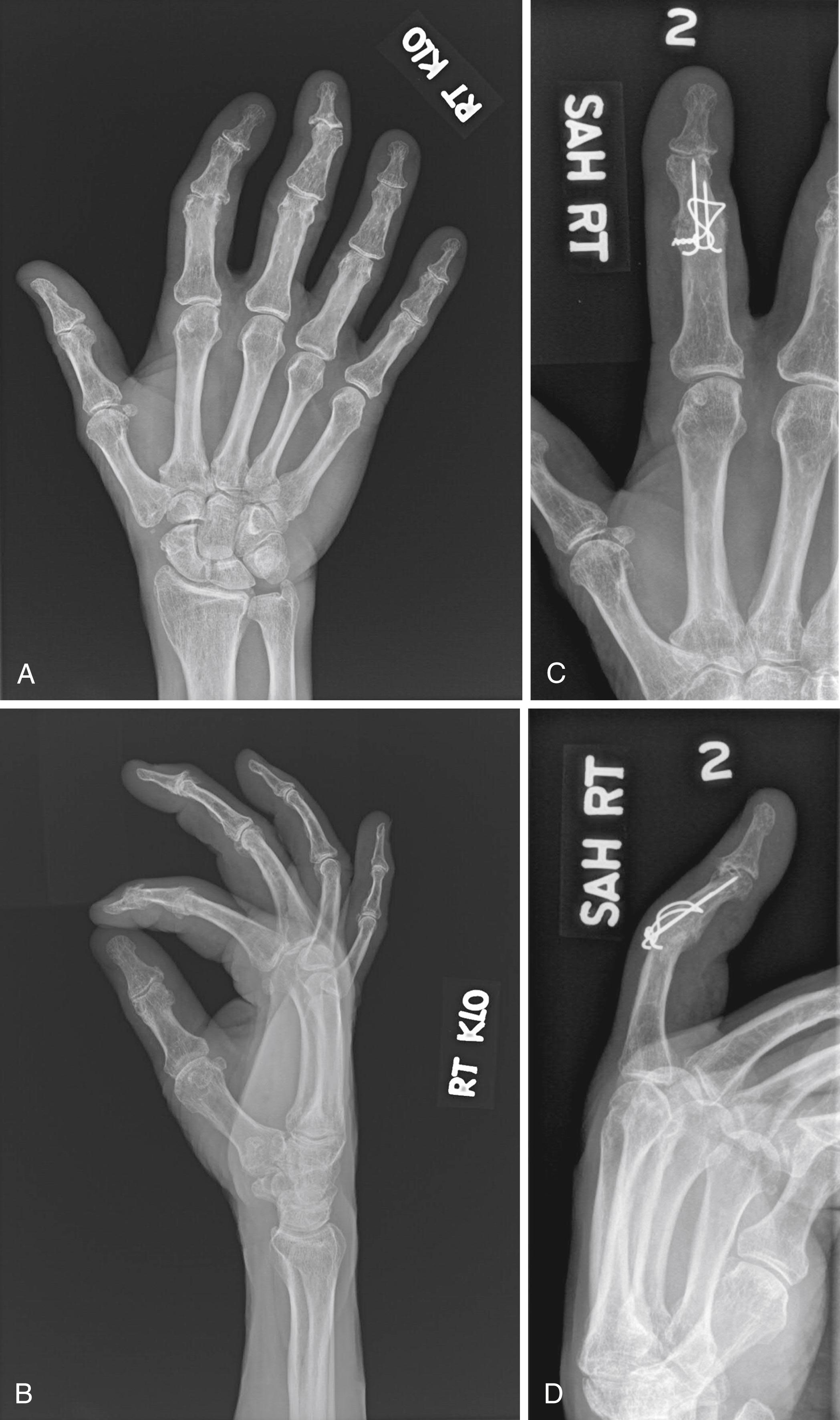
The wounds are inspected at postoperative day 5, and a rigid finger-based orthosis is fabricated that supports the affected digits. The patient is allowed to remove the orthosis and begin gentle active range of motion. At 4 weeks following operation, most activities of daily living are resumed. Radiographs are assessed at 6 weeks and 12 weeks for healing. Once radiographic bone healing has been achieved, the patient is released to full activity. The rationale behind tension band wiring of the PIP joint arthrodesis is that active flexion of the digit enhances compression of the arthrodesis surface. Caution should be exercised in the patient with osteopenia or osteoporosis.
High union rates have been reported using a number of fixation methods for PIP joint arthrodesis, including headless compression screws, Kirshner wire fixation, and tension band wiring/Kirshner wire techniques. , Carroll reported on 635 IP arthrodeses and found only a 5% nonunion rate. Stern et al. has reported a 97% fusion rate among 290 consecutive MCP and PIP joint arthrodeses using a tension band wiring technique. A 98% union rate (50 out of 51 PIP joints) with the use of a headless compression screw has been reported by Ayres and colleagues.
Throughout the arc of PIP joint flexion and extension, 5 degrees of adduction and 9 degrees of supination are anticipated. Loss of this degree of freedom, as would be expected with PIP joint arthrodesis, has been shown to alter precision pinch in the index finger PIP joint. Recent studies have suggested that PIP arthrodesis in the more intermediate angles of 40 to 60 degrees for all the digits may provide better superior grip and pinch strength. ,
Nonunion, malunion, hardware prominence, fracture, infection, skin necrosis, and complex regional syndrome have been described as complications following arthrodesis of the PIP joint. Ayres and associates reported fracture of the proximal phalanx following headless compression screw insertion. Leibovic and Strickland reported on 3 of 224 PIP arthrodesis patients who ultimately required amputation, 1 for osteomyelitis and the other 2 for complications following the development of reflex sympathetic dystrophy (RSD). Hardware removal can be anticipated in up to 9% of patients following PIP arthrodesis with Kirshner wire and tension band wiring.
Become a Clinical Tree membership for Full access and enjoy Unlimited articles
If you are a member. Log in here